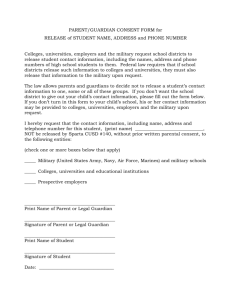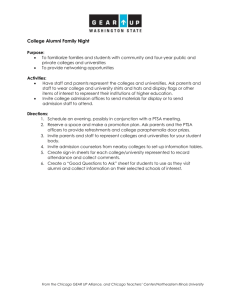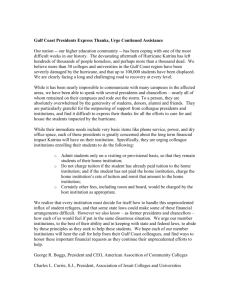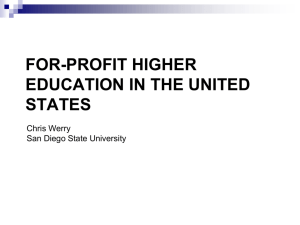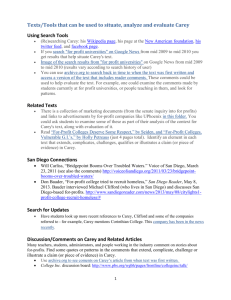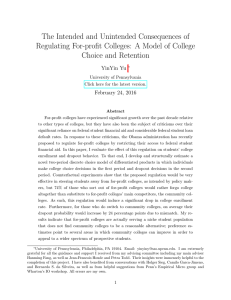Bureaucracy in Education
advertisement
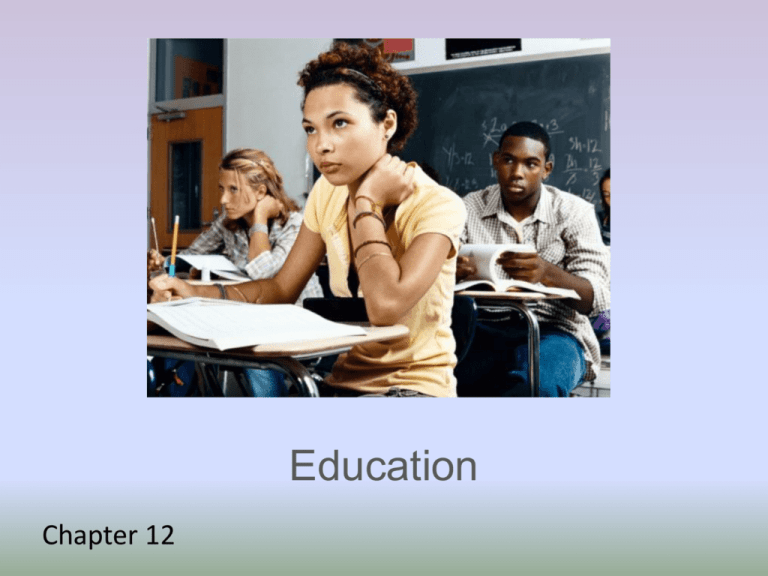
Education Chapter 12 Development of Education • The purpose of education is the transmission of knowledge. • Education – formal system of teaching, knowledge, values, and skills. • Early emphasis in American schools was on “civilizing” the young – Acculturation – transmission of culture from one generation to the next – Principle means for creating a uniform national culture – Horace Mann – proposed “common schools” – Mandatory education laws – 1918 Development of Education • Industrialization and universal education occurred at the same time. – Need for an educated workforce – Influx of “foreign values” – Americanize immigrants • After the turn of the 20th century, the emphasis shifted to education for jobs. – Industrialized Nations developed into credential societies • Degrees Bureaucracy in Education • Large-scale school systems are formal organizations, like factories, hospitals, and business firms. – 5 characteristics of bureaucracy evident in majority of schools: • • • • • 1) division of labor 2) hierarchy of authority 3) written rules and regulations 4) impersonality 5) employment based on technical qualifications • According to the bureaucratic model, education for large numbers of students is more efficient when students are homogeneous in development and ability. Bureaucracy in Education • According to critics of formal schooling, the school’s bureaucratic nature is unable to respond to the expressive, creative, and emotional needs of individual children. • Conflict theorists argue that the trend toward more centralized education has harmful consequences for disadvantaged persons. Functionalist Perspective • Manifest Functions of Education – Teach knowledge and skills • Schools disseminate knowledge not only in the classroom. • Innovation – the creation or discovery of new knowledge through research or creative thinking. • Certification Functionalist Perspective • Manifest Functions of Education – Cultural transmission of Values • basic norms, attitudes, beliefs, and values of the society. – Individualism, competition, and patriotism. – Social integration • Schools remain a major agent of socialization. Schools offer a diverse population a common identity. – Mold into more cohesive unit and socialize into mainstream culture. – National identity that stabilizes political system Functionalist Perspective • Manifest Functions of Education – Gatekeeping – selection and screening of talent • Tracking – placing students in curricula consistent with the school’s expectations for students’ eventual occupations. – Promotion of personal growth and development • Schools expose students to a wide variety of perspectives and experiences. Functionalist Perspective • Latent Functions of Education: – Family functions • child care, sex education, birth control advice. – Other functions: • • • • Matchmaking Social Networking Reducing the unemployment rate Stabilize society Conflict Perspective • Many believe that the U.S. is a meritocratic society, however there are recurring problems that indicate the model does not always work the way we think it does. – Meritocracy – social status is based on ability and achievement rather than social class or parental status. • all individuals have an equal chance to succeed and develop their abilities. • elite have structured public schools to reinforce the shared culture of their group. Conflict Perspective • Perpetuates Social Inequality – The Hidden Curriculum – refers to the unwritten rules of behavior and attitude taught in school in addition to formal curriculum – Discrimination by IQ – not only measure intelligence but also culturally acquired knowledge; reflect a cultural bias that favors middle class and discriminates against minority and lower-class students. • Different types of knowledge – Unequal Funding – stacks the decks against minorities and the poor – The Correspondence Principle – how schools correspond the social structure of society The Unequal Funding of Education The Correspondence Principle Feminist Perspective • Treatment of Women in Education – Oberlin College was first to admit women in 1833 – Many female students were encouraged to serve men and become wives and mothers – Educational discrimination is evident in university professorship and administrative positions, which are predominantly held by men. • In 21st century, sexism in: – Stereotypes in textbooks – Pressure to study traditional women’s subjects – Unequal funding for athletics • Women have made strides in continuing education Symbolic Interaction • Study face to face interaction inside the classroom. – Self-fulfilling prophecy – Rist research – In a coeducational setting: • Girls learn to talk softly, avoid certain subjects, defer to the alleged intellectual superiority of boys, and to emphasize appearance over intelligence. • Boys are more talkative in class, raise their hands more often, move around more, argue with teachers more, and get more of the teachers’ attention than do girls. Problems in US Education • Rising Tide of Mediocrity – Cheating on SATs – Grade Inflation – Functional Illiteracy – Social Promotion – Cheating by Administrators – Violence Solutions in US Education • Higher Standards – Raising them for Teachers – Raising them for Students • Warning About Higher Standards • School Choice • Sitebased Management Higher Education College Enrollment Several trends account for the continued increase in college enrollment. 1. despite a decline in the number of 18-24 year-olds, a substantially larger proportion of this age category is attending college 2. the number of students over age 24 attending college, particularly women, continues to grow 3. the number of students remaining in college after their first year has increased. Four Factors account for these trends: 1. fearful of declining enrollments, colleges and universities have mounted strong student recruitment campaigns. 2. low-paying service jobs increasingly replace high-paying manufacturing jobs, resulting in fewer attractive non-educational options for those with only high school diplomas 3. the increase in the number of community and branch colleges offers an opportunity for many who could not otherwise have enrolled to continue their education 4. the recession that began in 2008, with its persistently high unemployment, is fueling the increase as well. State Budgets and the Cost of College • At the same time that college enrollments are accelerating, state revenue shortfalls across the nation are spawning deep cuts in higher education budgets. • State colleges and universities have responded to reduced state funding by increasing both private funding and tuition charges. Economic Benefits of College • Is college worth the investment? – A college degree is a ticket to better jobs and higher incomes. • How strong is the relationship between occupational status and education? – The benefits of college are even more apparent occupationally. Community Colleges • College enrollment is at an all-time high. – The enrollment surge in American’s 12,000 community colleges contributes heavily to this continued growth of college enrollment. – In 2011, two-year schools accounted for over 43 % of the total number of students in public institutions of higher education. Distance Learning • What are the advantages of distance learning to colleges and universities? – Online instructional technology allows faculty to deliver pretty much the same content that they present in class, but for less money. For-Profit Colleges and Universities • How prevalent are for-profit colleges and universities? – In recent years strictly for-profit colleges and universities have arrived on the scene. – For-profit colleges and universities have about 3 million students annually. For-Profit Colleges and Universities • Compared to the total college student population of some 18 million, this is not particularly large. • Currently, they award a relatively small proportion of all degrees in higher education, only 15 percent of associate degrees and 4 percent of bachelor’s degree. Critiques of for-profit colleges and universities? • Most educators believe that for-profit colleges and universities undermine the intellectual integrity of higher education. • They charge that underqualified instructors are teaching underdeveloped courses. • Educators also lament the loss of personal interaction between teachers and students and between students and other students. • Moreover, there is the problem of accreditation and transfer of credits. Questions for Consideration • Can you think of specific examples from your educational experience that demonstrate a hidden curriculum? • What do you think are future impacts to higher education? How does this impact you?
